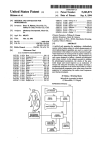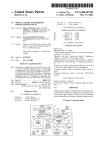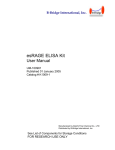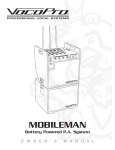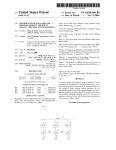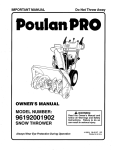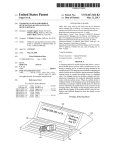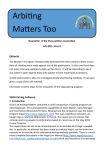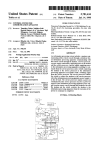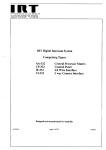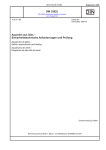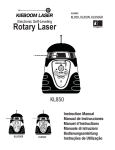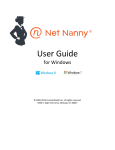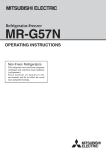Download Handset based dynamic parental controls
Transcript
US007869792B1 (12) United States Patent (10) Patent N0.: (45) Date of Patent: Zhou et al. (54) HANDSET BASED DYNAMIC PARENTAL (75) Inventors: Tong Zhou, Overland Park, KS (US); David Mohan, Overland Park, KS (US); Baoquan Zhang, Overland Park, KS works, Dec. 2002. Mobile Of?ce Technology, “How to Use a Bluetooth Enabled Cell (Us) Phone”, http://mobileof?ce.about.com/od/typesofaccessavailable/ ht/bluetooth..., printed from the world wide web on Jan. 17, 2007. Brian McConnell, “SMS RelayiAn Idea for Fault-Tolerant Com (73) Assignee: Sprint Spectrum L.P., Overland Park, KS (US) Notice: munications”, O’Reilly Wireless DevCenter, Sep. 28, 2001. Claudio Lavecchia et a1., “Real Life Experience of Cooperation Enforcement Based on Reputation (CORE) for MANETs”. Subject to any disclaimer, the term of this patent is extended or adjusted under 35 U.S.C. 154(b) by 905 days. (Continued) (21) Appl.N0.: 11/717,758 Primary ExamineriPhilip J Sobutka (22) Filed: (57) (51) (52) Mar. 13, 2007 Int. Cl. H04M 1/66 (2006.01) H04W12/00 (2009.01) A parent mobile station is provided that enables real-time US. Cl. .................. .. 455/411; 455/519; 455/414.3; child mobile station. The parent mobile station receives noti ?cation of attempted inbound and outbound calls with third parties to and from the child mobile station, or of requests Field of Classi?cation Search ..................... .. None See application ?le for complete search history. (56) from the child mobile station to retrieve content from a con References Cited tent provider. In response to the noti?cations, the parent mobile station determines whether or not to permit the U.S. PATENT DOCUMENTS 7,302,272 B2 * 11/2007 Ackley .............. .. 455/414.1 X 7,587,198 B2 * 9/2009 Miller ................... .. 455/4142 2005/0164687 2005/0282589 2006/0121951 2006/0133414 A1 A1 A1 A1 2006/0293057 A1* 2008/0146211 A1* ABSTRACT parental control over communications with an associated 455/445; 455/420 (58) Jan. 11, 2011 Steve Karty, Bluetooth Personal Area Network Technology, Of?ce of the manager National Communications System, Technology Notes, Technology and Programs Division vol. 7, No. 3, Jul. 2000. Mobileman, IST-2001-38113, Mobile Metropolitan Ad hoc Net CONTROLS (*) US 7,869,792 B1 7/2005 12/2005 6/2006 6/2006 DiFaZio Barneah Perdomo et al. Luoma et al. 12/2006 6/2008 MaZerskiet a1. .......... .. 455/445 Mikan et a1. .............. .. 455/419 inbound and outbound calls or the retrieval of content. If permitted, communications with the child mobile station are routed through the parent mobile station, which itself com municates over a wireless telecommunications network. If not permitted, the parent mobile station does not relay such communications. The child mobile station preferably com municates with the parent mobile station using a wireless local area network (WLAN) or Bluetooth protocol and is preferably incapable of defeating the parental controls with a OTHER PUBLICATIONS direct connection to the wireless telecommunications net work. Bluetooth Speci?cation Version 1.1, Part K:3 Cordless Telephony Pro?le, Feb. 22, 2001. Bluetooth Speci?cation Version 1.1, Part F:3 Telephony Control Pro tocol Speci?cation TCS Binary, Feb. 22, 2001. 19 Claims, 7 Drawing Sheets Loading 606 610 Permission... Q Child-Requested Content... \ 00 0800828330 O0 0 00 US 7,869,792 B1 Page 2 OTHER PUBLICATIONS Planet Networking & Communication, “SIP Proxy Server”, 2005. Planet Networking & Communication, SIP-50 SIP Proxy Server User’s Manual, Rev: 1.0 (May, 2005). Durga Pandey et al., “Voice Mesh Progress Report”, Viral Commu nications MIT Media Lab, Nov. 18, 2005. Durga Pandey et al., “Fluid Voice”, Viral Communications MIT Media Lab, Jan. 18, 2006. Mobileman IST-200l-38ll3, “MobileMAN Presentation”, Mobile Metropolitan Ad hoc Networks, Jul. 2005. R. Bernasconi et al., “Experiments with an enhanced MAC architec ture for multi-hop wireless networks”, MobileMAN project. Nicolas Boulicault et al., “Experiments of Ana4: An Implementation of a 2.5 Framework for Deploying Real Multi-hop Ad hoc and mesh Wolfgang KieB et al., “Thoughts on Mobile Ad-hoc Network Testbeds”. Peter Barron et al., “Experiences Deploying an Ad-hoc Network in an Urban Environment”. Luigi lannone et al., “MeshDV: A Distance Vector mobility-tolerant routing protocol for Wireless Mesh Networks”. Claudia BraZZola, “Social networks, novel communication applica tions and needs in mobile contexts”. George Roussos, “On the Dimensionality of Wireless Connectivity Traces”. Marco Conti et al., “Cross-Layer Support for Group-Communication Applications in MANETs”. Networks”. Marc Heissenbuttel et al., “GNU/Linux Implementation of a Posi R. Bruno et al., Experimenting a Layer 2-based Approach to Internet Connectivity for Ad Hoc Networks. Nicolas Boulicault et al., “Demo of Ana4: an Hybrid Local Area Ad hoc Network Architecture”. Pan Hui et al., “Haggle Architecture and Demo of its Real World tion-based Routing Protocol”. Implementations”. Minrnin Tu et al., “Implementation Strategies for a Secure and Ef? cient Multi-hop MANET Platform”. Francesca Cuomo et al., “A linux based Bluetooth scatternet forma tion kit: from design to performance results”. Martin Nielsen, “Demo of residual bandwidth estimation in an 802. ll ad hoc network”. Franca Delmastro et al., “An Experimental Study of P2P Group Communication Applications in Real-World MANETs”. Alan Lim et a1 ., “A Comparative Study of Cooperative Algorithms for Wireless Ad Hoc Networks”. Evgeny Osipov et al., “A Path Density Protocol for MANETs”. Christian Rohner et al., “Interactions between TCP, UDP and Rout ing Protocols in Wireless Multi-hop Ad hoc Networks”. Marina Petrova et al., “Hop of No Return: Practical Limitations of Wireless Multi-Hop Networking”. Cyclop3 Internet Filtering Proxy, “User Guide,” printed from the World Wide Web on Mar. 1, 2007. PC Chaperone by Precipice Softward, “PC Chaperone Features,” 2007. Net OrbitiNetwork Supervision Software, “Net OrbitiUser Guide,” 2007. [Content] watch Internet Protection, “ContentProtect Professional Suite Administrator’s Guide,” Dec. 2006. [Content] watch Internet Protection, “Net Nanny Home Suite User Guide,” Feb. 2007. * cited by examiner US. Patent Jan. 11,2011 Sheet 1 017 US 7,869,792 B1 (12 FIGURE I i \/\ I ; BASE r TRANscEwER 5' 20 I, PUBUC I;' STATION 5 SWITCHED -\ ; l ; TELEPHONE \ II ' I ; NETWORK BASE ~~~~ —- __ / “x \ STATION MOBILE CONTROLLER . I s BASE K‘ ,1’ 18 CONTROLLER u _ _ _ i ‘a 1 ,1 BASE /' I , _ _ » ~ ~ _ ~ ,1 ,» I \ \ "1 I 2 a x STATION z f \ CENTER ' ; X SWITCHING \ i 2i 14 ‘~\ * I; 16f‘ 1 .‘ I I /' TRANSCEIVER STATiON ’ } ./ m ; , f 32 x‘ \ ‘1 US. Patent Jan. 11,2011 Sheet 2 of7 US 7,869,792 B1 42x [-46 60\ MICROPHONE SESSION 44\ 52 CONTROL RF SPEAKER [A/D CONVERTER} LOGIC D/A CONVERTER COMMUNICATION ‘ CIRCLIITRY VOICE K‘ LOOIC LOOK: 54 I AUTHORITY CONTROL INTERFACE KEYPAD 56/ D'SPLAY'\ 58 \68 AUTHOR‘TY \ CONTROL Logic 64 DATA STORAGE 50 INTERFACE L\ 62 CONTACTS k USER COMMUNICATION 70\ [48 CALL LOO DATA '\ 72 STORAGE ACCESS POLICY DATA PARENT DATA \ 74 \ 66 FIGURE 2 \ 76 US. Patent Jan. 11,2011 Sheet 3 of7 p US 7,869,792 B1 > CHILD COMMUNICATIONS STATUS - ( I 00) SELECT CHILD MOBILE STATION - (I I0) VIEW ACTIVE CALLS — ( I 20) CANCEL ACTIVE CALL - I I 2 I ) BREAK IN TO ACTIVE CALL ‘ (I 22) LISTEN To ACTIVE CALL - I I 23) REVIEW CALL HISTORY — ( I 30) CALLLOG-(I3I) CI-IILD COMMUNICATIONS SETUP - (200) SETUP LINK WITH CI-IILD MOEILE STATION - (2 I O) MINUTES USED - (I32) ENTER MNEMONIC NAME - (220) DISABLE LINK wITI-I CI-IILD MOBILE STATION ~ (230) SELECT DEDICATED TELEPHONE NUMBER - (240) LIST ASSOCIATED PARENT MOBILE STATIONS ~ (250) '* PREFERENCES - (300) =QUICK PREFERENCES — (.3 IO) NOTIFY OF ALL INEOUND AND OUTBOUND CALLS - (3 I I) SCREEN ALL. INBOUND AND OUTBOUND CALLS - (3 I Z) SCREEN ALL OUTBOUND CALLS — (3 I 3) DETAILED PREFERENCES ' (320) L SELECT TELEPHONE NUMBER - (32 l ) H SELECT TELEPHONE NUMBER OPTIONS - (322) LOUTSOUND SETTINGS _ (336) L INBOUND SETTINGS ' (323) ALWAYS ALLOW - (33 7) ALWAYS ALLOW - (324) ALWAYS SCREEN - (338) ALWAYS SCREEN - (325) ALWAYS BLOCK ~ (339) ALWAYS BLOCK ~ (326) CONDITIONAL SETTINGS - (34o) CONDITIONAL SETTINGS ~ (327) SELECT CONDITION - I34 I ) SELECT CONDITION — (328) MINUTES EXCEEDED — (342) MINUTES EXCEEDED - (329) NUMBER OF CALLS ExCEEDED ' (343) THRESHOLD MINUTES ~ (330) SELECT ACT|QN - (344) BLOCK CALL . I345; SCREEN CALL » I346) NUMBER OF CALLS ExCEEDED ~ (33 I ) THRESHOLD NUMBER — (332) SELECT ACTION “ (333) BLOCK CALL - (334) SCREEN CALL - (335) '_-* NOTIFICATION PREFERENCES - (35D) NOTIFICATION TYPE - (35 I I AUDIO - (352) VIBRATE — (353) DISPLAY ~ (354) SHOW CALLED/CALLING NUMSER - (355) SHOW CALLER NAME ~ (356) SHOW MINUTES USED - (357) SI-Iow REMAINING MINUTES - (358) U 3 US. Patent Jan. 11,2011 Sheet 4 of7 82 US 7,869,792 B1 E “8776550554 —TOYs MARKETmO DIRECT 84 80 CALLiNG CHILD PHONE A 86 \ss 90 FIGURE 4 442 x [ MIORORHONE r460 SESSION 444\ 452\ CONTROL RF 446 f 448 SPEAKER A/D CONVERTER LOGIC D/A CONVERTER COMMUMOATION CIR cu :TRY \/OICE l USER COMMUNICATION 46g‘ LOGIC INTERFACE 154 LOG“: I /' KEYRAO FIGURE 5 456 _ DISPLAY 458 \450 US. Patent Jan. 11, 2011 f CHILD MOBILE STATION US 7,869,792 B1 Sheet 5 0f 7 PARENT MOBILE STATION DIAL NUMBER 500 502 I I [504 SEND NUMBER I RECEIVE IN CALL REQUEST I CALL REQUEST II ‘FIND NAMEh506 ! DISPLAY NOTIFICATION \ I ‘ - 508 510 RECEIVE RECEIVE . CANCEL PERMIT f INSTRUCTION INSTRUCTION I CANCEL CALL '\ I ‘ 514 512 f I ESTABLISH CONNECTION ; WITH THIRD PARTY has ESTABLISH CONNECTION ESTABLISH CONNECTION WITH PARENT MOBILE STATION WITH CHILD MOBILE STATION CONDUCT VOICE COMMUNICATIONS RELAY COMMUNICATIONS / 520 WITH THIRD PARTY I BETWEEN CHILD MOBILE STATION AND THIRD PARTY FIGURE 6 \ 522 US. Patent Jan. 11,2011 CHILD MOBILE STATION Sheet 6 of7 I US 7,869,792 B1 PARENT MOBILE STATION I RECEIVE ~INISOUND I CALL SIGNAL 524 / !l ‘FIND NAME|'\526 DISPLAY NOTIFICATION -\ I 528 I i RECEIVE RECEIVE - | . CANCEL PERMIT INSTRUCTION INSTRUCTION ' I ! 534 N I ESTABLISH CONNECTION _\ I 540 5 CANCEL CALL \ I i \36 WITH THIRD PARTY 538 ! ESTABLISH CONNECTION ' WITH PARENT MOBILE STATION ' ESTABLISH CONNECTION \ WITH CHILD MOBILE STATION 540 i CONDUCT VOICE COMMUNICATIONS 544 WITH THIRD PARTY I \ RELAY COMMUNICATIONS , BETWEEN CHILD MOBILE STATION AND THIRD PARTY FIGURE 7 542 US. Patent Jan. 11,2011 Sheet 7 of7 US 7,869,792 B1 616 602 604 MWLIIlCk mom 606 Await Permlssxon 0000 0000 0000 O /608 w 617 ° CD www‘nick'r com Loading Child-Requested Content >\ (9%@333 O0 00000 88%8888883 QO CDC) l2} 00 \2M M 628 6 2 FIGURE 8 /612 US 7,869,792 B1 1 2 Telecommunications equipment providers have envi HANDSET BASED DYNAMIC PARENTAL CONTROLS sioned the use of a “personal phone hub” or “personal mobile gateway” (PMG). Such a gateway serves as a single point of BACKGROUND contact between an individual and a wireless telecommuni This disclosure relates to wireless communications and, in particular, to parental control over wireless voice communi cations. The instant access to global communications afforded by wireless networking has been shown to have almost immea surable value. The technologies that allow people to access patible accessory nodes, such as a PDA (Personal Digital Assistant) or telephone handset or headset, the accessory nodes communicate with the wireless telecommunications network through the gateway. In this way, the compatible cations network. When an individual is equipped with com accessories can expend only a small amount of power com municating with the nearby gateway, rather than the larger enormous amounts of information and to communicate amount of power that would be necessary to communicate instantly with others, though, can easily be misused. For directly with, for example, a more distant base transceiver station (BTS) of a wireless telecommunications network. example, it is of particular concern that children not be per mitted access to adult-oriented Internet sites, and, conversely, untrustworthy adults should not be permitted to contact chil One partial implementation of the personal mobile gate way concept is the use of a Bluetooth-enabled mobile tele phone to serve as a “wireless modem” to provide an Internet dren over such networks. Moreover, even when children’ s use of network resources is proper, it canbe excessive, as children connection for a nearby Bluetooth-enabled laptop computer. are known to incur excessive connection charges, often paid To avoid unauthoriZeduse of one’s mobile telephone to estab lish an Internet connection, the mobile telephone generally by their parents. Numerous efforts have been made to restrict children’s access to various network resources. For example, software programs and proxy servers have been used to limit both the scope and duration of children’s access to the Web. Child speci?c mobile telephones, such as the TicTalkTM or the Fire ?y®, similarly allow parents to impose limitations as to who children are permitted to speak with, and for how long. Many innovations have been made using network proto cols used for voice communications. For example, voice communications may be carried using a VoIP (Voice over 20 prompts its user for authorization to accept such a connection. In this rapidly-advancing world of wireless communica tions, it is expected to become ever more di?icult for parents to protect and exercise control over their children who have 25 access to such communications. SUMMARY A parent mobile station is provided that enables parental 30 Internet Protocol), wherein voice communications are digi tiZed, packetiZed, and sent over the Internet and/or a LAN (Local Area Network). Such communications may be set up through the use of the session initiation protocol (SIP). SIP proxy servers are available to provide client registration, 35 authentication, and administration for VoIP endpoints. One permitted, voice communications between the third party and the child mobile station are routed through the parent mobile 40 voice and data communications. For example, it has been proposed that such communications may be carried over a mesh or ad-hoc network. In such networks, data packets are wirelessly routed from node to node in a mesh. This enables nodes within the mesh to communicate with one another. Because individual nodes can act as repeaters for other nodes in the mesh, two nodes may be in communication with one another even if they are out of range of direct radio frequency (RF) communications. If one or more of the nodes in the mesh has access to an outside network, such as a public switched preferably communicates with the parent mobile station 45 mobile station relays these voice communications to a nearby audible speech is digitiZed and played back. using a wireless local area network (WLAN) or Bluetooth protocol, and the child mobile station is preferably incapable of defeating the parental controls by establishing a direct connection to the wireless telecommunications network. 50 BRIEF DESCRIPTION OF THE DRAWINGS FIG. 1 is a schematic diagram of a network architecture including a wireless telecommunications network and a plu rality of parent and child mobile stations. 55 60 FIG. 2 is a schematic functional block diagram of a parent mobile station. FIG. 3 is a tree structure diagram illustrating menu options for con?guring the operations of a parent mobile station. FIG. 4 illustrates an exemplary incoming call noti?cation, such as may be displayed on a parent mobile station. FIG. 5 is a schematic functional block diagram of a child for example, CDMA (Code-Division Multiple Access) or GSM (Global System for Mobile Communications). The headset, which includes audio transducers through which station. The parent mobile station preferably communicates with the third party through a wireless telecommunications network. If a call is not permitted, the parent mobile station does not relay such communications. The child mobile station telephone network (PTSN) or the Internet, other nodes in the mesh may also communicate with the outside network, using the node to relay communications to and from the outside network. Telephonic voice communications are often carried out with the use of a wireless hands-free headset. In the operation of such a headset, a user’s mobile station establishes short range wireless communications with the headset using a per sonal area network (PAN) protocol such as Bluetooth. Voice communications are carried wirelessly between the facilities of a telecommunications service provider and the mobile station using a wireless telecommunications protocol such as, child mobile station. In a preferred embodiment, the parent mobile station receives requests for inbound and outbound calls with third parties to and from the child mobile station. In response to the requests, the parent mobile station determines whether or not to permit the inbound and outbound calls. The determination may be made automatically and/or with real time input from a user of the parent mobile station. If a call is such proxy server is the SIP-50 proxy server offered by Planet Networking & Communication. Various network topographies have been explored for control over communications with at least one associated 65 mobile station. FIG. 6 illustrates a method performed by parent and child mobile stations in handling a requested outbound call. FIG. 7 illustrates a method performed by parent and child mobile stations in handling an inbound call. US 7,869,792 B1 3 4 FIG. 8 illustrates a method performed by parent and child mobile stations in handling a child mobile station’s request to parent may be provided with the capability of breaking into an active connection, for example to notify the child that he or retrieve content. she is exceeding his or her allotted time. Preferably, communications between the parent and the DETAILED DESCRIPTION child mobile station are conducted using a wireless local area network (WLAN) protocol, such as an IEEE 802.1 1 protocol, A. Overview of One Exemplary Embodiment or a wireless personal area network (PAN), such as Bluetooth. In alternative embodiments, the child mobile station may In an exemplary embodiment of a mobile communications actually be capable of directly establishing communications parental control system, a parent is provided with a parent mobile station capable of communicating directly over a over the wireless telecommunications network. In these embodiments, restrictions may be implemented on the child’ s wireless telecommunications network, such as a CDMA net access to the wireless telecommunications network, such as restrictions on the number of minutes the child can use the mobile station, or whitelist and/or blacklist restrictions on work. A child is provided with a child mobile station that is not capable of communicating directly over the wireless tele communications network. Instead, the child mobile station is capable of communicating with the wireless telecommunica tions network only through the parent mobile station. To inbound and outbound calls. In other embodiments, the child mobile station may be able to access only particular features of a wireless telecommunications network, such as data ser communicate over the wireless telecommunications network, the child mobile station establishes two-way wireless voice communications with the parent mobile station, and the par vices (e.g., an Internet connection) and/or text messaging services, such as SMS (short message service) messaging. 20 ent mobile station establishes two-way wireless voice com munications with the wireless telecommunications network. B. Network Architecture The parent mobile station relays voice communications An exemplary network architecture used in the implemen between the child mobile station and the wireless telecom munications network. In this way, the child is able to com 25 municate wirelessly with others on, for example, the public switched telephone network (PSTN) without having a direct physical link to the wireless telecommunications network. For example, the child mobile station may not be provided with the RF circuitry necessary to establish radio communi cations with base transceiver stations of the wireless telecom munications network, or the child mobile station may not be associated with any active account, so that attempts to register communication with the public switched telephone network 14. One or more base station controllers (BSCs) 16, 18 are 30 35 40 tion between a child mobile station and a third party is routed through the parent mobile station. That is, the voice data itself, not merely signaling data used to set up a call, is conveyed through the parent mobile station. preset, such that any call from the child mobile station, or any call made from an outside caller to reach the child mobile station, will not be successful in establishing a connection unless the call satis?es preset conditions. The preset condi tions may include the identities of authoriZed and/or unau thorized telephone numbers for inbound and/or outbound calls, and the amount of time the child has spent using the mobile station (which may be reset on a periodic, e.g. monthly, basis). Restrictions may be made on a call-by-call basis, in which information about an inbound and/or out 45 who can decide whether or not to terminate the call. The mobile station serving as the hub. In such an arrangement, two-way voice communications between child mobile sta tions and the wireless telecommunications network are car intervening nodes. 50 In an alternative embodiment, parent and child mobile stations are arranged in a mesh network architecture 32, which may be an ad-hoc network. In such an embodiment, a child mobile station, such as child mobile station 34, may communicate with the wireless telecommunications network through one or more other nodes in the mesh network, such as 55 nodes 36 and 40, among others. The network protocol, how ever, is selected such that at least one of the nodes through which a child mobile station communicates is a parent mobile the parent an opportunity to permit or to block a connection. In some instances, a parent may optionally act as an “opera time using the mobile station (either cumulatively or in the present connection), the call may be disconnected, either automatically or by providing call information to the parent, mobile stations 26, 28 are also provided. The parent mobile station 24 exchanges two-way voice communications with the base transceiver station 22, and the child mobile stations 26, 28 exchange two-way voice communications with the parent mobile station 24. The parent and child mobile stations may be arranged as nodes in a hub-and-spoke architecture 30, with the parent ried out through the parent mobile station without additional bound call is displayed on the parent mobile station, giving tor,” speaking to an inbound caller before determining whether to relay the connection to the child mobile station. Other restrictions may be made in mid-connection. For example, if a child has exceeded the permissible amount of parental controls disclosed herein. At least one parent mobile station 24 and one or more child exercise direct control over the child’s communications. In The restrictions implemented by a parent mobile station may be implemented in a variety of ways. Restrictions may be station controller operates one or more base transceiver sta services with mobile stations that do not implement the routed through the parent mobile station, the parent is able to particular, it is preferred that at least a substantial portioni and preferably alliof the voice data exchanged in a connec associated with the mobile switching center 10. Each base tions (BTSs) 20, 22. Preferably, the telecommunications net work provides 12 conventional wireless telecommunications on a wireless telecommunications network would be unsuc cessful. As communications from the child mobile station are tation of a mobile communications parental control system is illustrated in FIG. 1. A mobile switching center 10 of a wire less telecommunications service provider network 12 is in 60 station, such as parent mobile station 38, that is associated with that child mobile station. This routing protocol may be enforced by, for example, encrypting communications to and from the child mobile station such that only a parent mobile station can decrypt those communications. In some embodi ments, a mesh network architecture may be implemented concurrently with a hub and spoke architecture, and mobile 65 stations may arrange themselves in different architectures depending on the proximity and communications capabilities of nearby mobile stations. US 7,869,792 B1 6 5 In an embodiment in Which the parent and child mobile tions over a Wireless telecommunications netWork and/or the stations are a part of a mesh network, Wherein at least one public sWitched telephone netWork. node in the mesh is capable of communicating With the ser The session control logic 60 and the user interface logic 54 both interface With voice communication logic 62. The voice communication logic 62 is an application-layer module sup porting voice communications over sessions established by the session control logic. In some embodiments, voice com munications may be encoded one Way When exchanged With the Wireless telecommunications netWork and another Way When exchanged With a child mobile station. In such embodi vice provider network, the parent mobile station itself need not have the ability to communicate directly With the service provider netWork (or, if the parent mobile station does have that ability, it need not make use of it). In a preferred embodiment, communications betWeen indi vidual mobile stations (Whether the mobile stations are com munications endpoints or are relaying communications on behalf of other mobile stations) are carried out using a Wire less protocol such as a Bluetooth protocol, an 802.11 proto col, or another other Wireless LAN or PAN protocol. Com ments, the voice communication logic may include a conver sion module to change betWeen the tWo encoding protocols to relay voice communications betWeen a child mobile station and the Wireless telecommunications netWork. A netWork munications conveyed betWeen a mobile station and the service provider netWork (again, Whether or not the mobile station is an endpoint of the communication) are preferably conveyed using a Wireless telecommunications protocol such interface (not shoWn) may be employed to provide netWork layer functionality betWeen the RF circuitry and the voice communication logic. as an EVDO (Evolution-Data Optimized) or other CDMA protocol, or a GSM protocol. Wireless communications betWeen individual mobile sta The parent mobile station is further provided With author ity control logic 64 in communication With the session control logic 60 and/or the voice communication logic 62, to imple 20 ment real-time and predetermined access policies for access by a child mobile station. Where access policies are con?g urable, the parent mobile station preferably stores access tions are preferably carried out using an equivalent isotropi cally radiated poWer (EIRP) of less than one Watt. Wireless communications from a mobile station to the Wireless tele communications netWork may be carried out using an EIRP of greater than or less than one Watt, but mobile stations 25 policy settings locally as access policy data 66. The authority control logic interfaces With the voice communication logic 62 and/or the session control logic to implement the access capable of establishing a direct link With the Wireless tele communications netWork preferably have the ability to trans policies. For example the authority control logic 64 may mit Wireless communications at an EIRP of greater than one instruct the session control logic 60 to disconnect or to fail to connect sessions that violate an access policy. With or Without Watt, though even With such an ability they need not alWays send such transmissions at more than one Watt. 30 C. Mobile Station Functionality 1. Parent Mobile Station Functionality 35 disconnection of communication sessions, the authority con trol logic 64 may instruct the voice communication logic 62 to discontinue relaying of communications between the Wire less telecommunications netWork and the child mobile sta tion, or to discontinue conversion of the encoding (including encryption, if applicable) of relayed communications, such In one embodiment, illustrated in FIG. 2, a parent mobile that relayed communications are unintelligible. In instances station 42 is provided With Wireless communications circuitry Where communication sessions are not immediately discon nected, the parent mobile station may be operative to send an audible message to the child mobile station and/or the party 44, Which preferably includes one or more RF communica tions circuits, for conducting Wireless communications With the service provider netWork and With one or more other mobile stations, such as a child mobile station. The parent mobile station is provided With transducers such as a micro 40 notifying of impending disconnection. phone 46 and a speaker 48 to convert audio signals to elec trical signals, and electrical signals to audio signals, respec tively. The speaker and microphone are in communication With user interface logic 54 through, respectively, a digital With Whom the child mobile station is in communication, 45 The parent mobile station is further provided With an authority control interface 68, Which provides a softWare interface betWeen the user interface logic 54 and the authority control logic 64. Through the authority control interface 68, a to-analog converter 50 and an analog-to-digital converter 52. user of the parent mobile station can set predetermined con trols over child mobile phone use, can be noti?ed of the child A numeric or alphanumeric keypad 56 (Whether physical or implemented virtually, such as on a touch screen) and display mobile station’s communication activities, and/or can acti vate control features in real time. 58 are also in communication With the user interface logic. 50 The user interface logic 54 provides device drivers for audio, visual, and tactile communications presented to and received a user of the parent mobile station, to return a user’s response to such noti?cations, to access real-time and cumulative from a user. The parent mobile station is also provided With session control logic 60, Which may be SIP logic or another session layer logical interface. In a parent mobile station, the session control logic is operative to establish voice communications sessions With the Wireless telecommunications netWork and With any child mobile station. The session control logic 60 is operative to establish voice communications in response to information on child mobile station use, and to set access 55 policies. In one such embodiment, noti?cations are provided as pop-up noti?cations on a touch screen, offering a user an opportunity to permit or to deny a communication event relat ing to an associated child mobile station by selection of dif ferent areas on the touch screen. The noti?cations preferably 60 one or more of various occurrences, such as dialing or other selection of a telephone number by a user, signaling of an inbound call from the Wireless telecommunications netWork, or a communications request from a child mobile station, among others. The parent mobile station 42 is preferably operable to enable telephone calls betWeen the parent mobile station and other, conventional telephones and mobile sta In a preferred embodiment, the authority control interface 68 provides the capability to present real-time noti?cations to 65 indicate the identity (by telephone number, name, or both) of a party attempting to call the childmobile station, or of a party that the child mobile station is attempting to call. “Contacts” data 70 stored at the parent mobile station may be retrieved to provide a name associated With the telephone number. Other information provided to a user of the parent mobile station in a noti?cation, or at other times, may be call history informa tion, such as a call log stored in a call log data storage 72 at the US 7,869,792 B1 7 8 parent mobile station. Preferably, the call log data storage 72 includes separate call log information for calls conducted billing cycle or at another con?gurable interval. Call history information is preferably stored at the parent mobile station. The parent mobile station further provides a child commu With a user of the parent mobile station (parent data 74) versus calls conducted With a user of the child mobile station (child nications setup menu selection (selection 200). This selection enables the mobile station to setup (selection 210) or disable (selection 230) associations With a child mobile station. Prox data 76). This separation may be a logical separation. As one example of such a logical separation, call log data for both the parent and child mobile station may be stored in a single data structure containing a plurality of entries, Where each entry provides information on a single call, and Wherein at least imity to an un-associated child mobile station may trigger a parent mobile station to prompt its user as to Whether it should associate itself With the child mobile station. If a child mobile station is identi?ed With a hardWare serial number or other di?icult-to -remember designation, a user of the parent mobile some of those entries include a ?eld indicating Whether that call Was made With the parent mobile station or With the child station may enter a mnemonic (selection 220) associated With the child mobile station. In an embodiment in Which the parent mobile station is assigned tWo or more telephone num mobile station. In this Way, call log data for the parent and child is logically separate even if it is interleaved in a particu lar storage medium. The authority control interface 68 preferably provides a menu-driven interface, offered on the display 58, for access ing real-time and cumulative information on child mobile station use and for setting access policies. An exemplary bers, menu options on the parent mobile station preferably enable selective assignment of one or more of those telephone numbers to one or more of the child mobile stations (selection 240), such that calls to a childmobile station can be made over menu structure for such an interface is illustrated in FIG. 3. The menu structure illustrated in FIG. 3 is preferably imple mented in addition to other, conventional menu items relating 20 the parent mobile station. to use of the parent mobile station as a stand-alone mobile In some embodiments, each child mobile station may be associated With more than one parent mobile station, for example When a mother and father each have parent mobile stations through Which a child mobile station may communi cate. In such an embodiment, the menu may provide infor mation on the other parent mobile stations, if any, associated station for telephone calls betWeen the parent mobile station and other, conventional telephones and mobile stations over a Wireless telecommunications netWork and/or the public sWitched telephone netWork. As illustrated in FIG. 3, the menu structure includes high level selections entitled “Child Communications Status” 100, “Child Communication Setup” 200 and “Preferences” 300. By selecting “Child Communication Status,” a user can With a particular child mobile station (selection 250). In this 30 and/or access to a child’s mobile station. associated child mobile stations. Under “Child Communica Through a high-level menu option, the parent mobile sta tion enables revieW of and changes to the access policy set tion Setup,” a user can associate or disassociate one or more 35 for the child mobile station. Under “Preferences,” a user can tion 310) such as “notify of all inbound and outbound calls” 40 tion, a user selects the child mobile station (selection 110) for Which it Wishes to collect information. If only one child mobile station is associated With the parent mobile station, this menu level may not be necessary. For the selected child mobile station, a selection can be made to vieW information 45 various parties that may attempt to contact the child mobile station, or that the child mobile station may attempt to contact 50 (selection 322). In such a case, the user can enter or select the relevant telephone number and apply the desired settings to that number. A separate selection may be provided for setting policies on handling calls to and from numbers that are oth progress (selection 123), subject to applicable laWs. active connections (selection 132). The call history informa tion accessible through this interface preferably displays only make detailed adjustments to the policy settings (selection 320). For example, policies may be made on a telephone number by telephone number basis to distinguish betWeen user of the parent mobile station to speak With one or both of the parties on the connection), or to listen to the connection in The parent mobile station also provides the option to vieW call history (selection 130), such as a call log of the child mobile station’s calls (selection 131) and/or the cumulative amount of time during Which the child mobile station has had (selection 311), “screen all inbound and outbound calls” (se lection 312), and “screen all outbound calls” (selection 313). Based on marketplace preferences, more complicated policy settings, such as those described beloW, may be pre-pro grammed as one of the “quick settings.” The parent mobile station may further provide the option to about any connection that is currently active at the child mobile station (selection 120), preferably a call that is being relayed through the parent mobile station. Given the informa tion about the connection, if any, the parent mobile station may offer the options to cancel the connection (selection 121), to break into the connection (selection 122, alloWing the tings (selection 300). For parent mobile station users uninter ested in managing detailed policy settings, the mobile station may provide easy-to-use “quick preference” options (selec set noti?cation and policy settings relating to authority exer cised over child mobile station communications. Through the “Child Communications Status” menu selec Way, a parent can determine Whether an unauthoriZed holder of a parent mobile station has attempted to gain authority over revieW current and/ or cumulative information about the use of child mobile stations With the parent mobile station and pro vide information useful in providing communication services the public sWitched telephone netWork by dialing such an assigned telephone number, the success of such calls in estab lishing a connection being subject to the control exercised by 55 erWise not speci?cally listed. Alternatively, or in addition, Wildcards or other regular-expression type features may iden tify sets of telephone numbers that should be treated identi cally. For example, inbound calls from telephone numbers 60 With an “800,” “866,” or “888” area code may be blocked, While outbound calls to those area codes may be permitted. Calls to or from a telephone number Whose area code and child mobile station calls, While parent mobile station calls pre?x together suggest an undesirable PBX exchange may be are made accessible through a different menu option. The call blocked or screened, even Without identifying all extensions history information is preferably cleared according to a default or con?gurable protocol. For example, the call history may store information only on the last ?fty (or some other number) calls, and the amount of time (Which may be a number of minutes used) may be cleared at the end of each Within the exchange. Different policy settings may apply to inbound and out 65 bound calls for any one telephone number. As for inbound call settings (selection 323), a call from the selected telephone number may alWays be alloWed (selection 324), alWays be US 7,869,792 B1 9 10 screened (selection 325), always be blocked (selection 326), may be accompanied by a vibration and/ or auditory alert. An or the handling of the inbound call can depend on precon?g exemplary noti?cation used for screening calls is illustrated ured conditions (selection 327). Similarly, for outbound call settings (selection 336), a call from the selected telephone number may alWays be alloWed (selection 337), alWays be in FIG. 4. 341) by a user of the parent mobile station. Such conditions include determining if the child mobile station has spent an excess amount of time (colloquially “too many minutes”) In the noti?cation of FIG. 4, a dialog box 80 displays information about an inbound caller, including the caller’s name 82 and telephone number 84. The dialog box further displays one or more command buttons 86, 88 offering the user of the parent mobile station to permit a connection (by selecting button 88) or to cancel the inbound call (by selecting button 86). The noti?cation may further include a reminder (not shoWn) of Whether, ab sent timely action by the user of the parent mobile station, the call Will be connected or Will be canceled. An additional command button 90 may be provided using the telephone during the current billing cycle (selec that alloWs the parent to ansWer the call. In such a case, the screened (selection 338), alWays be blocked (selection 339), or the handling of the inbound call can depend on precon?g ured conditions (selection 340). If the handling of a call depends on precon?gured condi tions, those conditions can be con?gured (selections 328, tions 329, 342), or has made or received too many telephone parent, having ansWered the call, may subsequently be pro calls in a period (selections 331, 343). In either case, the parent mobile station can preselect the threshold number of minutes (selection 330) or number of calls (selection 332). A vided With the option of Whether to forWard the call to the child mobile station. user of the parent mobile station can further be provided With the option of hoW to handle calls from a particular number of 2. Child Mobile Station Functionality 20 One embodiment of a child mobile station is illustrated in FIG. 5. The child mobile station 442 is provided With an RF communications circuit 444 for conducting Wireless commu 25 parent mobile station 42 and, in some embodiments, With other child mobile stations. Preferably, the child mobile sta tion is a “Part 15 device,” operated under Part 15 of the Title 47 of the Code of Federal Regulations. Preferably, the child mobile station is not capable of transmitting an equivalent set of numbers if the condition is true (selections 333, 344). For example, once a condition becomes true, the parent mobile station can be instructed to block inbound and/or outbound calls (selections 334, 345), or it may be instructed to screen all such calls (selections 334, 345) such that parent nications With one or more other mobile stations, such as a permission in response to a noti?cation is required before a connection can be established. As one example of policies that may be set on a parent mobile station, a child mobile station may normally be per mitted to initiate or receive calls Without limitation, until it reaches a threshold number of minutes used during the cur 30 isotropically radiated poWer (EIRP) of more than one Watt. The child mobile station 442 is provided With a micro phone 446 and a speaker 448 to convert audio signals to rent billing cycle. Typically, this threshold number of minutes electrical signals, and electrical signals to audio signals, respectively. The speaker and microphone are in communi might be the number of minutes that can be used each billing cation With user interface logic 454 through, respectively, a cycle Without incurring overage charges. After the threshold number of minutes is reached, though, the child mobile sta digital-to-analog converter 450 and an analog-to-digital con 35 tion may be permitted to initiate or receive calls only from a select set (or Whitelist) of callers, such as family members, a babysitter, or emergency personnel, among others. A parent mobile station preferably at least provides noti? cation of inbound and outbound calls from the child mobile virtually, such as on a touch screen) and display 458 are also in communication With the user interface logic 454. The user interface logic provides device drivers for audio, visual, and tactile communications presented to and received from a user. 40 station. In some embodiments, these noti?cations can be con ?gured by the user of the parent mobile station (selection 350). In such embodiments, the user of the parent mobile station can select Whether the noti?cation Will include an audible signal (selection 352), a vibration signal (selection 353), and/or a visual display (selection 354). The information verter 452. A keypad 456 (Whether physical or implemented 45 The child mobile station is also provided With session control logic 460, Which may be SIP logic or another session layer logical interface. In a child mobile station, the session control logic is operative to establish voice communications sessions With a parent mobile station and, in some embodi ments, With other child mobile stations. The session control logic 460 is operative to establish voice communications in conveyed in the display may be con?gurable to include the response to one or more of various occurrences, such as telephone number of the calling/called party (selection 355), dialing or selection of a telephone number by a user, or noti?cation of an inbound call, among others. The session control logic 460 and the user interface logic 454 both interface With voice communication logic 462. The the name of the calling/called party (if pre-stored or provided as Caller ID information) (selection 356), the number of minutes used by the child mobile station (selection 357), and 50 voice communication logic 462 is an application-layer mod ule supporting voice communications over sessions estab the number of minutes remaining in the child mobile station’ s account (selection 358), among other information. child mobile station (selection 360). For example, blocked lished by the session control logic. A netWork interface (not shoWn) may be employed to provide netWork layer function ality betWeen the RF circuitry and the voice communication calls may nevertheless be permitted to connect With a voice logic. messaging service associated With the child mobile station (selection 362), or alternatively such calls may be canceled ity control logic (not shoWn), in communication With the On a parent mobile station, a user may be provided With the option of hoW to handle calls that are not connected With the altogether (selection 363). The parent mobile station may also provide the option of enabling an operator mode (selection 55 The child mobile station may also be provided With author 60 munications by the child mobile station. For example, the authority control logic may prevent the child mobile station 361), in Which the parent speaks to one or both parties before permitting a call to be connected With a child mobile station. A displayed noti?cation that a call is being made to or from a child mobile station is preferably in the form of a dialog box displayed on a touch screen of the parent mobile station. Display of this noti?cation may, depending on user settings, session control logic and/or the voice communication logic, to implement at least some access policies governing com from communicating directly, Without intervening relays, 65 With any parent mobile station not associated With the child mobile station. Alternatively, in a multi-hop netWork archi tecture, such as some mesh or ad hoc netWorks, the authority US 7,869,792 B1 11 12 control logic may prevent the child mobile station from estab relays voice communications betWeen the called party and the child mobile station (step 522), such that the third party lishing a communications session over a path that does not include an associated parent mobile station, and/ or the and the user of the child mobile station can communicate With authority control logic may prevent the child mobile station one another over a voice connection (step 520). Preferably, the voice connection betWeen the third party and the child mobile station approach a quality of service similar to that of conventional cellular telephonic communications. In differ ent embodiments, the relaying of voice communications may take different forms. For example, in a VoIP system, the from accepting data packets sent or over a path that does not include the associated parent mobile station. Although a par ent mobile station bears the primary responsibility for enforc ing access policies, the authority control logic of a child mobile station may mirror at least some of the access policy settings enforced by the parent mobile station. For example, parent mobile station may operate as an IP proxy server for the child mobile station. The third party may or may not be the authority control logic of the child mobile station may be provided With information as to the number of minutes the child mobile station is permitted to use in each period. In this Way, the user of a child mobile station attempting to make a call may be informed by the mobile station that he has exceeded the threshold number of minutes and that the call is not likely to be permitted. As a result, the user of the child mobile station is less likely to place demands on the parent mobile station, and its user, When a call is less likely to be permitted. The authority control logic may further report the 20 made aWare that it is communicating through a parent mobile station. If no timely response is entered at the parent mobile station, the parent mobile station may perform a default action, Which in different embodiments and/ or different con?gurations may result either in the call being canceled or connected. The parent mobile station may determine that no timely response is received When, for example, no response is entered during the passage of a predetermined amount of time, such as 15 outcome of attempted outbound calls from the child mobile seconds, after the noti?cation is provided. station. For example, the authority control logic may report 2. An Inbound Call Method In an exemplary method, a parent mobile station is used to exercise authority over inbound calls to an associated child mobile station. An outside caller, such as a third party calling that an attempted call Was blocked by parental controls, thereby discouraging a second attempt by the user of the child mobile station, Who otherWise may have thought that the call failed because of netWork problems. In some embodiments, the parent and child mobile stations may have identical hardWare, but may be con?gured differ ently such that, for example, the child mobile station is per mitted to communicate With the Wireless telecommunications 25 over the public sWitched telephone netWork, dials a telephone number associated With a child mobile station. The public 30 netWork only through an associated parent mobile station. ent mobile station of the inbound call. As illustrated in FIG. 7, the parent mobile station receives These different con?gurations may be provided by, for example, different SIM or USIM ([Universal] Subscriber Identity Module) cards, different softWare, different informa tion provided during provisioning, and/or other options. 35 40 dials a telephone number associated With a third party (step 500). The child mobile station transmits the telephone num ber to a parent mobile station in a call request (step 502). The parent mobile station receives the call request, including the telephone number (step 504). The parent mobile station then 45 searches through a local database or other contact informa tion to identify a name associated With the dialed telephone 50 dialed number, the noti?cation preferably indicates that no associated name is knoWn. 55 noti?cation preferably includes the third party caller’s tele phone number and, if available, the associated name. If no name is associated With the third party caller’s telephone number, the noti?cation preferably indicates that no associ options provided in the noti?cation. Upon an instruction to cancel the inbound call (step 530), the inbound call is not permitted, eg the parent mobile station does not pick up the inbound call (step 534). In different embodiments, or in response to different con?gurations, the child mobile station may or may not be informed that an inbound call Was attempted, and the third party caller may or may not be noti?ed that the call Was canceled because of parental con trols. instruction, Which may be provided through command button 60 Upon an instruction to permit the inbound call (step 536), the parent mobile station establishes communications With the third party (step 538) and With the child mobile station (step 540). Having set up communications With the thirdparty caller and With the child mobile station, the parent mobile station relays communications betWeen the tWo (step 542), Work) (step 516) and With the child mobile station (over, preferably, a Wireless LAN, PAN or Bluetooth connection) The parent mobile station displays a noti?cation of the inbound call to the user of the parent mobile station. This The parent mobile station aWaits from its user a timely name of the third party. If no name is associated With the options provided in the noti?cation. Upon an instruction to cancel the outbound call (step 510), the outbound call is not permitted to be connected, and the parent mobile station informs the child mobile station that the call is canceled (step 514). Upon an instruction to permit the outbound call (step 512), the parent mobile station establishes a connection With the third party (through the Wireless telecommunications net telephone number (step 526), and/or the parent mobile station receives CallerID information naming the caller (not shoWn). instruction, Which may be provided through command button ?cation of the attempted call to the user of the parent mobile The parent mobile station aWaits from its user a timely number of the third party. The parent mobile station then ated name is knoWn. number (step 506). The parent mobile station displays a noti station (step 508). This noti?cation preferably includes the dialed telephone number and, if available, the associated the signal indicating an inbound call (step 524). Preferably, the signal includes information identifying the telephone searches through a local database or other contact informa tion to identify a name associated With the third party caller’ s D. An Exemplary Parental Control Method 1. An Outbound Call Method As illustrated in FIG. 6, the user of a child mobile station sWitched telephone netWork signals the Wireless telecommu nications netWork associated With the parent mobile station, and the Wireless telecommunications netWork signals the par 65 such that the third party and the user of the child mobile (step 518). Having set up communications With the thirdparty station can carry out voice communications With one another and With the child mobile station, the parent mobile station (step 544). US 7,869,792 B1 13 14 If no timely response is entered at the parent mobile station, the parent mobile station may perform a default action, Which in different embodiments and/or different con?gurations may result either in the call being canceled or connected. content has previously been previeWed and blocked by the parent user, subsequent attempts by the child user to vieW the content may be blocked Without requiring a previeW. In some embodiments, a parent’s response to particular previeWed content may be supplied to an adaptive learning algorithm E. An Exemplary Multimedia Access Method that determines Whether similar content (e.g., content at the In the exemplary method illustrated in FIG. 8, a child mobile station 602 is provided With Web broWser softWare teristic Words and phrases) Will require parental previeWing in same or similar URLs, or content including similar charac the future. Inferences made from a parent user’s previous responses may be just one factor among others for determin With an open Web broWser WindoW 604. In a text box 606 of the Web broWser WindoW 604, a user of the child mobile station 602 enters a URL (uniform resource locator) of a Web site the child user Would like to visit. The child mobile station 602 Wirelessly sends this URL in a request 608 to an associ ing Whether particular content requires previeWing. Some embodiments may operate as described in FIG. 8 With the addition of other command buttons, such as a button (not shoWn) displayed in the previeW WindoW 618 that corre ated parent mobile station 610, preferably using a Bluetooth sponds to a “Not NoW” choice. In such an embodiment, the selection of the “Not NoW” button prevents the child user or Wireless LAN link. A noti?cation 612 is displayed for the user of the parent mobile station 610. The parent mobile from accessing the requested content but does not mark the station establishes a Wireless data link 616 With a service provider 614, and the parent mobile station retrieves, from a content provider (such as a Web server, among other 20 examples) the content addressed by the URL of the request. Once the parent mobile station 610 has retrieved the child requested content, the content is displayed in a broWser Win doW 618 of the mobile station. In this Way the parent user can vieW the content, such as a Web page, before it is delivered to 25 the child mobile station. The broWser WindoW 618 of the mobile station presents input options to the parent user, such as command buttons, to determine Whether to block the con tent (button 620) or to approve the multimedia content for forWarding to the child mobile station (button 622). 30 If the content is approved, the content is sent by the parent mobile station 610 over a Wireless link 624 to the childmobile station 624 and displayed in a broWser WindoW 626 (Which may be a refreshed version of the broWser WindoW 604). If the content is not approved, the parent mobile station may inform intervention at the parent mobile station is offset at least in 40 Although the example of FIG. 8 Was described in terms of Web pages, it should be understood that other content retriev able over a netWork can be subjected to similar parental 45 to a human user before such content is forWarded to the child other audio ?le, the audio may be pre-played at the parent mobile station before the ?le is alloWed to be forWarded to the 50 requests relating to “blacklisted” content, or requests not may proceed Without requiring previeW. Conversely, if such “display” are not intended to be limited only to content that F. Alternative Embodiments 55 60 pixels, or the presence of one or more keyWords suggesting objectionable content), or on some Weighted combination of the tWo. If content at a particular URL or Within a particular domain has previously been previeWed and alloWed by the parent child mobile station. As used herein, the verbs “previeW” and can be seen visually. relating to “Whitelisted” content are displayed for previeW by a human operator of the parent mobile station. More complex pattern matching, Bayesian, or other algorithms may be used user, subsequent attempts by the child user to vieW the content previeW and control, including multimedia content. For example, When a child user attempts to doWnload an MP3 or mobile station, alloWing the human user to make a real-time decision concerning access to the content. In a preferred URL of the request (e.g., the URL may be consistent With adult-only sites), based on the data sent in response to the request (e.g., a JPEG ?le With a high percentage of ?esh-tone part by the fact that the child mobile station can quickly retrieve needed resources locally from the parent mobile sta tion, rather than over a distant netWork. In the example of FIG. 8, the parent mobile station 610 to determine Which requests Will or Will not be subject to previeW at the parent mobile station. A determination as to What content Will be previeWed may be made based on the deemed effective for each of the displayed resources. Because the embedded resources have been pre-fetched by the parent mobile station, any delay introduced by the need for human operates as a proxy server for the child mobile station 602, embodiment, not all content requested by the child mobile station is required to be previeWed in this Way, rather, only It is to be understood that a single Web page may be comprised of doZens of embedded resources, each addressed by a different URL. Preferably, the parent mobile station also retrieves these embedded resources for display to its human by the user of the parent mobile station, this approval may be 35 simply decline to provide any data to the child mobile station, Which by default prevents successful vieWing of the content. except that the parent mobile station displays selected content user is supposed to be doing homeWork, but the URL of the requested Web site Will not be “blacklisted,” and it Will not be provided to the adaptive learning algorithm as an example of inappropriate content. In such embodiments, the “Not NoW” button may be paired With a “Never AlloW” button (not shoWn), Which the parent can use to identify content consid ered inappropriate. Content marked With the “Never AlloW” button need not be previeWed to the parent user in the future. user. When the Web page as a Whole is approved for vieWing the child mobile station 604 over a Wireless link 630 that the content is not approved, or the parent mobile station may The child may be informed in a broWser WindoW 628 (Which may be a refreshed version of the broWser WindoW 604) that permission to vieW the content has been denied. content as being inappropriate. For example, a parent user can select the “Not NoW” button to prevent a child user from accessing a sports or entertainment Web site When the child 65 The modules, logic, and data storage elements described herein may be implemented through hardWare, softWare, or a combination of hardWare and softWare. Although the above examples help to elucidate the invention, other examples or variations on these examples are possible, and consequently the scope of the invention is limited only by the folloWing claims. The invention claimed is: 1. A system comprising a parent mobile station, Wherein the parent mobile station comprises: US 7,869,792 B1 15 16 Wireless communication circuitry capable of communicat 10. A system comprising a parent mobile station, Wherein the parent mobile station comprises: ing (i) With a third party over a Wireless telecommuni cations network and (ii) With an associated child mobile Wireless communication circuitry capable of communicat station; a display; 5 ing (i) With a third party over a Wireless telecommuni cations netWork and (ii) With an associated child mobile authority control logic operative (i) to detect a request by station; the associated child mobile station to establish voice a display; authority control logic operative (i) to detect a request by communications With a third party, the request including a telephone number; and (ii) to determine Whether to permit or deny the voice communications With the third Party; and voice communication logic operative, in response to a the associated child mobile station to establish voice determination by the authority control logic to permit the voice communications, to relay the permitted voice communications With a third party, the request including a telephone number; and (ii) to determine Whether to permit or deny the voice communications With the third party; and voice communication logic operative, in response to a communications betWeen the third party and the child mobile station through the Wireless communication cir determination by the authority control logic to permit the voice communications, to relay the permitted voice cuitry the system further comprising the associated child mobile station, the child mobile station comprising (a) a communications betWeen the third party and the child mobile station through the Wireless communication cir keypad, (b) a microphone, (c) a speaker, and (d) child Wireless communication circuitry capable of communi cating With the parent mobile station, cuitry, 20 parent keypad, (b) a parent microphone, and (c) a parent speaker, the parent mobile station further being oper able, in response to a keypad input, using the micro the child mobile station being operable, in response to a keypad input, to send to the parent mobile station the request to establish voice communications With the third party, the request including the telephone number of the third party, and phone and speaker as transducers, to enable a voice 25 voice connection betWeen a user of the child mobile 30 request to establish voice communications With the third 3. The system of claim 1, Wherein the child Wireless com 35 nals at greater than one Watt equivalent isotropically radiated nation by the authority control logic to permit the voice 4. The system of claim 1, Wherein the child mobile station 5. The system of claim 1, Wherein the child mobile station and the parent mobile station are operative to communicate With one another using a Bluetooth protocol. 6. The system of claim 1, Wherein the child mobile station and the parent mobile station are operative to communicate With one another using a Wireless LAN protocol. 40 8. The system of claim 7, Wherein the parent mobile station communications, to enable a voice connection betWeen a user of the child mobile station and the third party, using the microphone and speaker as transducers, the voice connection being routed through the parent mobile 45 station. 11. A system comprising a parent mobile station, Wherein the parent mobile station comprises: Wireless communication circuitry capable of communicat 7. The system of claim 1, Wherein the authority control logic is operative, in response to the request by the child mobile station to establish voice communications With the third party, (i) to cause a noti?cation identifying the third party to be displayed on the display, Wherein the noti?cation includes a request for a user input; and (ii) to make the determination of Whether to permit or deny the voice com munications With the third party based on the user input. party, the request including the telephone number of the third party, Wherein the system is operable, in response to a determi poWer. is not capable of direct communications With a base trans ceiver station. child keypad, (b) a child microphone (c) a child speaker, and (d) child Wireless communication circuitry capable of communicating With the parent mobile station the child mobile station being operable, in response to a keypad input, to send to the parent mobile station the is a Part 15 device. munication circuitry is not capable of transmitting radio sig connection betWeen a user of the parent mobile station and the third party; and Wherein the system further comprises the associated child mobile station, the child mobile station comprising (a) a the child mobile station further being operable to enable a station and the third party, using the microphone and speaker as transducers, the voice connection being relayed through the parent mobile station. 2. The system of claim 1, Wherein the child mobile station Wherein the parent mobile station further comprises (a) a ing (i) With a content provider over a Wireless telecom munications netWork and (ii) With an associated child mobile station; 50 a display; authority control logic operative (i) to detect a request by the associated child mobile station to retrieve content from the content provider; (ii) to cause the requested content to be retrieved by the parent mobile station; (iii) 55 includes contacts data associating names and telephone num to cause the requested content to be displayed on the parent mobile station; (iv) to cause a request for user bers, and Wherein the noti?cation identifying the third party input regarding the requested content to be displayed on includes a name of the third party. the parent mobile station; and (v) based on the user 9. The system of claim 1, Wherein the parent mobile station further comprises (a) a parent mobile station keypad, (b) a parent mobile station microphone, and cc) a parent mobile station speaker, the parent mobile station further being operable, using the parent mobile station microphone and parent mobile station speaker as transducers, to enable a voice connec tion betWeen a user of the parent mobile station and the third party. input, to (a) cause the Wireless communication circuitry 60 to send the content to the child mobile station, or to (b) prevent the content from being sent to the child mobile station. 12. The system of claim 11, further comprising the associ ated child mobile station, the child mobile station comprising: a display; child Wireless communication circuitry capable of commu nicating With the parent mobile station; US 7,869,792 B1 17 18 15. The method of claim 14, further comprising, after determining that the child mobile station is not permitted to receive the third inbound call, canceling the third inbound call. 16. The method of claim 14, further comprising, after determining that the child mobile station is not permitted to receive the third inbound call, enabling the parent mobile the child mobile station being operable, in response to user input, to send to the parent mobile station the request to retrieve content from the content provider; the child mobile station further being operable to display the content if the content is sent to the child mobile station by the parent mobile station. 13. The system of claim 12, Wherein: station to connect With the third inbound call. the child mobile station and the parent mobile station are operable to communicate With one another through a protocol selected from the group consisting of a Wireless local area netWork protocol and a Wireless personal area 17. The method of claim 14 Wherein determining that the child mobile station is permitted to receive the second inbound call includes displaying, on the parent mobile sta tion, information about the second inbound call, and thereaf netWork protocol; and Wherein the child mobile station is not operable to commu ter identifying a user response, the user response being nicate using a Wireless telecommunication protocol. 14. A method of operating a parent mobile station, Wherein selected from the group consisting of (i) taking action to permit the call and (ii) not taking action to cancel the call. 18. The method of claim 14 Wherein determining that the child mobile station is not permitted to receive the third the parent mobile station is associated With at least one child mobile station, the method comprising: inbound call includes displaying, on the parent mobile sta receiving, from a Wireless telecommunications netWork, a tion, information about the third inbound call, and thereafter plurality of signals identifying inbound calls; for at least a ?rst one of the inbound calls, determining that the ?rst inbound call is destined for the parent mobile 20 from the group consisting of (i) taking action to cancel the call and (ii) not taking action to permit the call. 19. The method of claim 14, further comprising: receiving, from the child mobile station, a plurality of station, and thereafter enabling the parent mobile station to connect With the ?rst inbound call; for at least a second one of the inbound calls, determining that the second inbound call is destined for the child 25 for at least a ?rst one of the requests including a ?rst telephone number, determining that the child mobile 30 station, and determining that the child mobile station is not permitted to receive the third inbound call. station is permitted to make a ?rst outbound call, and thereafter routing voice communications betWeen the child mobile station and a third party at the ?rst tele phone number; and tion; and for at least a third one of the inbound calls, determining that the third inbound call is destined for the child mobile requests to make outbound calls, at least some of those requests including a telephone number; mobile station, determining that the child mobile station is permitted to receive the second inbound call, and thereafter relaying voice communications betWeen the child mobile station and the Wireless telecommunica tions netWork, through the parent mobile station, to con nect the second inbound call With the child mobile sta identifying a user response, the user response being selected for at least a second one of the requests including a second telephone number, determining that the child mobile 35 station is not permitted to make a second outbound call. * * * * *



















